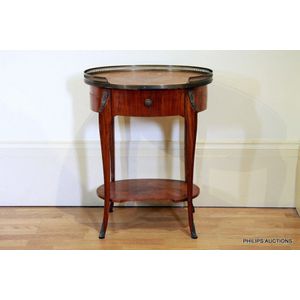Transitional Marquetry Gueridons with Chinese Figures
You must be a subscriber, and be logged in to view price and dealer details.
Subscribe Now to view actual auction price for this item
When you subscribe, you have the option of setting the currency in which to display prices to $Au, $US, $NZ or Stg.
- Apron - A decorative wooden panel that sits underneath the top surface of a table or chair, and unites the top of the piece with the legs, running at right angles to the underside. On carcase furniture such as a chest or wardrobe, the apron sits below the drawers or doors and attaches to the legs.
On carcase furniture without legs the panel under the drawers or doors sits on the floor and is termed a plinth.
An apron can provide a decorative touch to an otherwise unadorned piece of furniture and at the same time provide structural support and strength. They can be carved or pierced and quite elaborate. - Gueridon - The French term originally the name for a small stand for a candelabrum, but now used to describe any small circular topped table or pedestal, often with an intermediate shelf and on three legs..
- Bronze - An alloy of copper and tin, traditionally in the proportions of about 9 parts of copper to 1 part of tin.
The discovery of bronze in Western Asia in the 4th century enabled people to create metal objects which were superior to those previoulsy possible because of its strength and hardness, and it has been used throughout the world for weapons, coins, tools, statuary and other decorative items.
It is very fluid in a molten state, and its hardness, strength when set, and non-corrosive properties makes it most suitable for casting sculpture. - Marquetry - In marquetry inlay, contrasting woods, and other materials such as ivory, shell and metal are inlaid either as panels or in a single continuous sheet over the surface of the piece. The design may be straightforward, such as a shell pattern or a basket of flowers, or it may be infinitely complex, with swirling tendrils of leaves, flowers and foliage, such as one finds, for example, in the "seaweed" patterns on longcase clocks of the William and Mary and Queen Anne periods.
- Inlay - Decorative patterns inserted into the main body of a piece of furniture, generally in wood of contrasting colour and grain, though brass, ivory, ebony, shell and sometimes horn have been used. Inlay may consist of a panel of well figured timber inset into a cabinet door front, geometric patterns, or complex and stylized designs of flowers, swags of foliage, fruits and other motifs. As a general rule, in pieces where the carcase is constructed in the solid, the inlay is relatively simple such as stringing, cross banding and herringbone banding. Where more elaborate and decorative work was required veneer was used. Inlay has been fashionable from at least the latter half of the 17th century, when a variety of elaborate forms were developed
- Mounts - Mounts are used to describe bronze, brass and ormolu adornments on furniture especially quality furniture in the rococo and classical revival style, and are also the cabinet makers' name for the metal fittings on furniture, such as hinges, locks and handles, and metal edges and guards which protect furniture from damage.
This item has been included into following indexes:
Visually similar items

A transitional style tulipwood and marquetry gueridon, early 20th century, the oval table with a pierced brass gallery and floral inlay to quarter veneer panels, a frieze drawer and raised on hipped and tapering curvaceous legs united by an undertier, heig

A Louis XV style inlaid kingwood poudreuse, circa 1950s, a fine kidney shaped table with feather banding, half and quarter veneering to reserves with satinwood stringing, the central reserve with an inlaid floral bouquet, opening to reveal a mirror and a f

A pair of early Victorian mahogany carvers, circa 1840s, with a plain spade back and mid rail and having generously curved and scroll end arms, and drop in seats above turned legs; upholstered in cream and blue green sateen; bearing the partial label of th

A Jacobean style oak drop side table, early 20th century. in warm tonings, the oval table having barley twist legs and fold out stretcher based supports with square form bases and ball feet. Height 73 cm. Width 106 cm. Depth 79 cm
